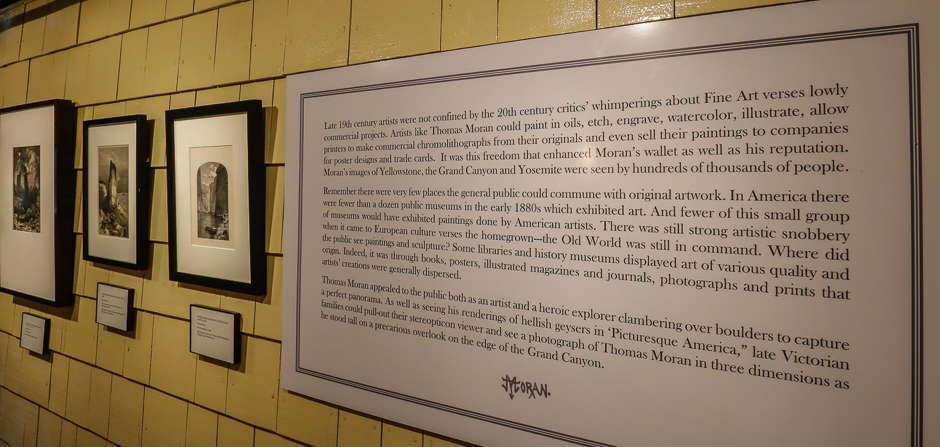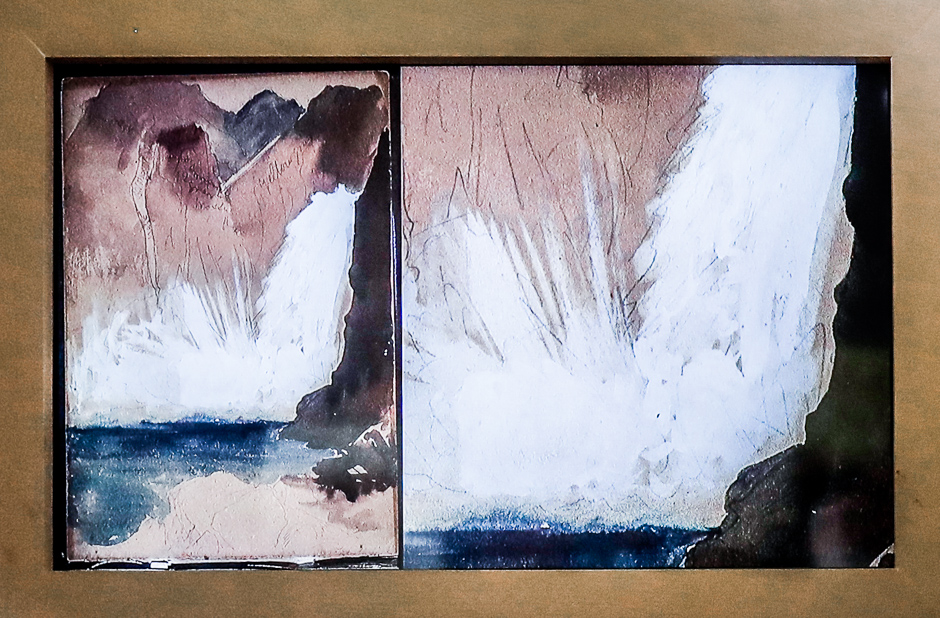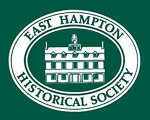
Detailing Moran’s adventurous participation in the Hayden Expedition to Wyoming, this enlightening collection of watercolors, sketchbook pages, oil paintings and even his expedition pistol, form the core of what will be an illustrated story of this journey and the national legacy of Thomas Moran. The largest portion of this exhibit is material that is returning to The Studio after being gifted to Yellowstone National Park in the 1940s.
We will supplement this rare loan from the National Park Service with period maps, stereographic cards, wood engravings, photographs and important, late 19th century publications that support this story of Thomas Moran, the founder of East Hampton’s artists’ colony.
Exhibition curated by Richard Barons.
~~~~~~~~~~~~~~~~~~~~~~~~~~~~~~~~~~
EXHIBIT CLOSED
THOMAS AND MARY NIMMO MORAN STUDIO
============================================
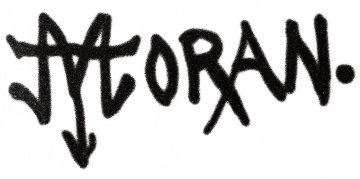
Nicknamed “Yellowstone Moran”, Thomas Moran created monogram that incorporates his initials TM and Y for Yellowstone and the Indian projectile point for the canyon’s original owners.
~~~~~~~~~~~~~~~~~~~~~~~~~~~~~~~~~~
THOMAS MORAN
DISCOVERS THE AMERICAN WEST
~~~~~~~~~~~~~~~~~~~
“Wonders of the Yellowstone”
Thomas Moran was still a young artist when at 33 years old and married with three children, he had his eureka moment.
Moran knew early in his youth that he had a proclivity for drawing. He took an apprenticeship with a Philadelphia wood-engraving firm and being a quick study, he progressed from carving other artists’ work into a woodblock, to supplying his own drawings. Abruptly terminating his contract with the firm, he started studying with his older brother Edward in about 1853. Edward Moran was already was a successful landscape and marine painter.
The first reference to Thomas Moran exhibiting his artwork was in 1856, at the Pennsylvania Academy of Fine Art, with several watercolors. The two Moran brothers began taking sketching trips to dramatic areas like the Delaware Water Gap. Together in 1862 they ventured to Europe for inspiration. It was in England that Thomas Moran came under the spell of Joseph Mallord William Turner. Turner’s painterly romantic renditions of land and seascapes, that swirled with energy and awesomeness, completely decimated Moran’s traditional idea of topographic representation of a landscape. Turner’s work was an inspiration that would follow Moran for the rest of his career.
On his return, the artist was able to support himself by this painting and illustration work. He married fellow artist Mary Nimmo in 1863 and three years later took his family to France, Italy and England, returning in 1867.
In the winter of 1870, the managing art department editor of Scribner’s Magazine commissioned Moran to illustrate an article “Wonders of the Yellowstone” by Nathaniel Langford. It needed illustrations. The only visual material available were rough sketches made by two engineer/draftsmen who were part of the Washburn-Doane Expedition. Moran was able to transform them into fourteen impressive ink/wash drawings for the magazine’s engraver. The finished illustrations portrayed the majestic and extraordinary rock formations, deep ravines and wide vistas. Moran had never seen anything like these extraordinary landscapes.
He was so enamored by these images of a powerful naturally sculpted landscape awaiting an artist to depict it, that he had Scribner’s Magazine write the leader of the expedition F. V. Hayden, to request that Thomas Moran could join the 1871 U.S. Geological & Geographical Survey to the Head-Waters of the Yellowstone. Though Moran got the blessings of Scribner’s and the Northern Pacific Rail Road, he had to borrow money from friends and use some of his paintings as collateral for loans, so he could pay his way.
Thus began Thomas Moran’s love affair with the American West. His paintings, watercolors, etchings, chromolithographs and engravings promoted the beauty and power he experienced in the heart of nature. These amazing depictions of our West, inspired American pride and encouraged the movement to preserve these almost sacred places.
~~~~~~~~~~~~~~~~~~~~~~~~~~~~
“For the first time in my life I slept out in the open air…got up early enough…to get our breakfast and commence photographing as soon as the sun rose.” — Moran Journal, 1871.
————————–
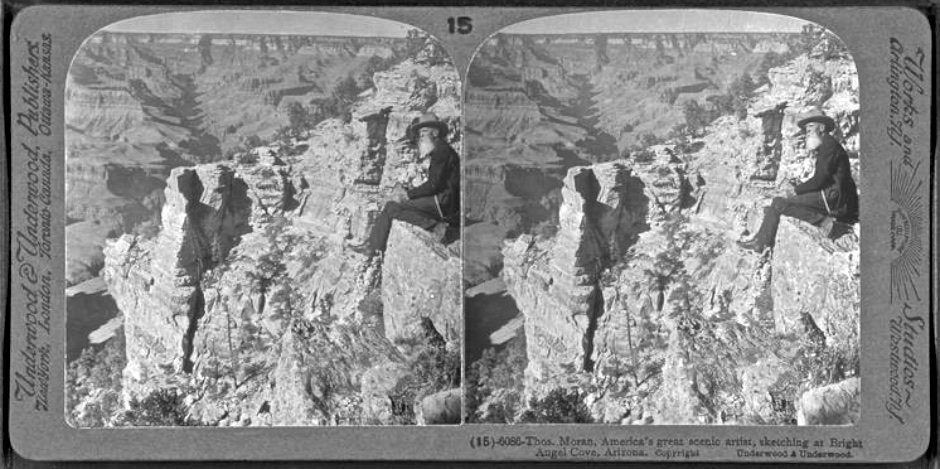
Caption: Thos. Moran, America’s Great Scenic Artist, Sketching at Bright Angle Cover, Arizona.
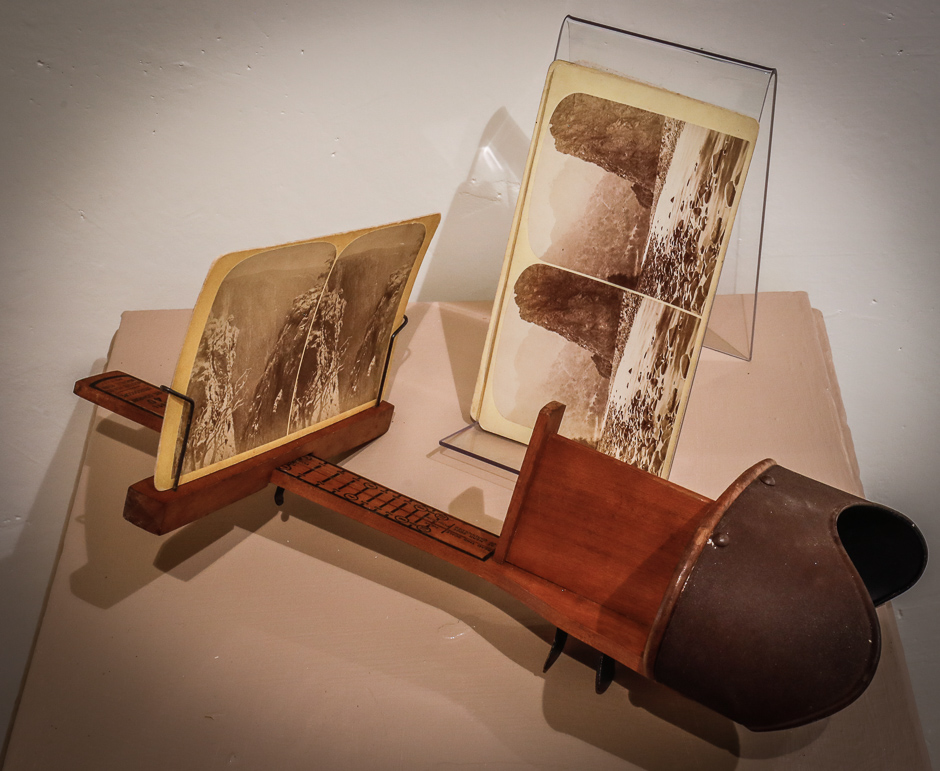
Antique Stereo Scope Viewer.
————————–

~~~~~~~~~~~~~~~~~~~~~~~~~~~~
“After descending to the shore of the lake, some of the party fished in it, and caught a few of the finest trout that I have yet seen.” — Moran Journal, 1871.
————————–
Late 19th Century Artists
Late 19th century artists were not confined by the 20th century critics’ whimperings about Fine Art verses lowly commercial projects. Artists like Thomas Moran could paint in oils, etch, engrave, watercolor, illustrate, allow printers to make commercial chromolithographs from their originals and even sell their paintings to companies for poster designs and trade cards. It was this freedom that enhanced Moran’s wallet as well as his reputation. Moran’s images of Yellowstone, the Grand Canyon and Yosemite were seen by hundreds of thousands of people.
Remember there were very few places the general public could commune with original artwork. In America there were fewer than a dozen public museums in the early 1880s which exhibited art. And fewer of this small group of museums would have exhibited paintings done by American artists. There was still strong artistic snobbery when it came to European culture verses the homegrown—the Old World was still in command. Where did the public see paintings and sculpture? Some libraries and history museums displayed art of various quality and origin. Indeed, it was through books, posters, illustrated magazines and journals, photographs and prints that artists’ creations were generally dispersed.
Thomas Moran appealed to the public both as an artist and a heroic explorer clambering over boulders to capture a perfect panorama. As well as seeing his renderings of hellish geysers in ‘Picturesque America,” late Victorian families could pull-out their stereopticon viewer and see a photograph of Thomas Moran in three dimensions as he stood tall on a precarious overlook on the edge of the Grand Canyon.
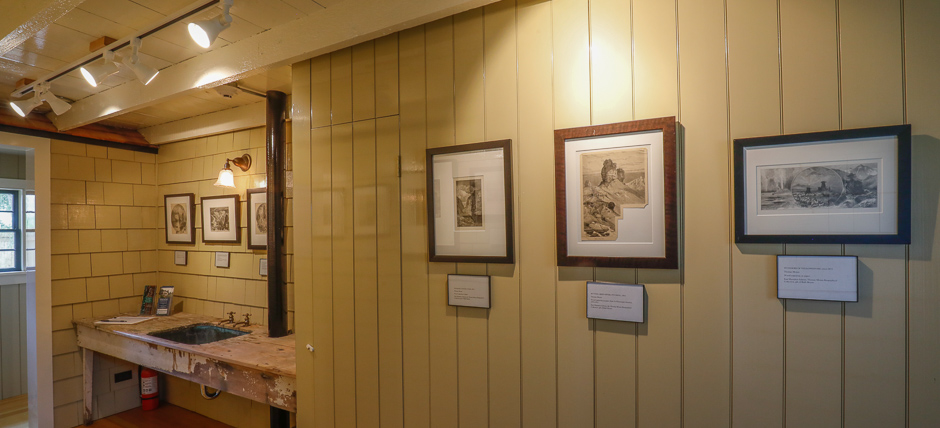

‘The Grand Canyon of the Yellowstone River: The Heart of the Continent, 1871.’ Wood Engraving on Paper by Thomas Moran. East Hampton Library, The Thomas Moran Biographical Collection, gift of Ruth Moran.
—————–

‘Buttes, Green River, Wyoming, 1874’ by Thomas Moran. Wood engraving on paper done for Picturesque America, 1872 – 1874. East Hampton Library, The Thomas Moran Biographical Collection. Gift of Ruth Moran.
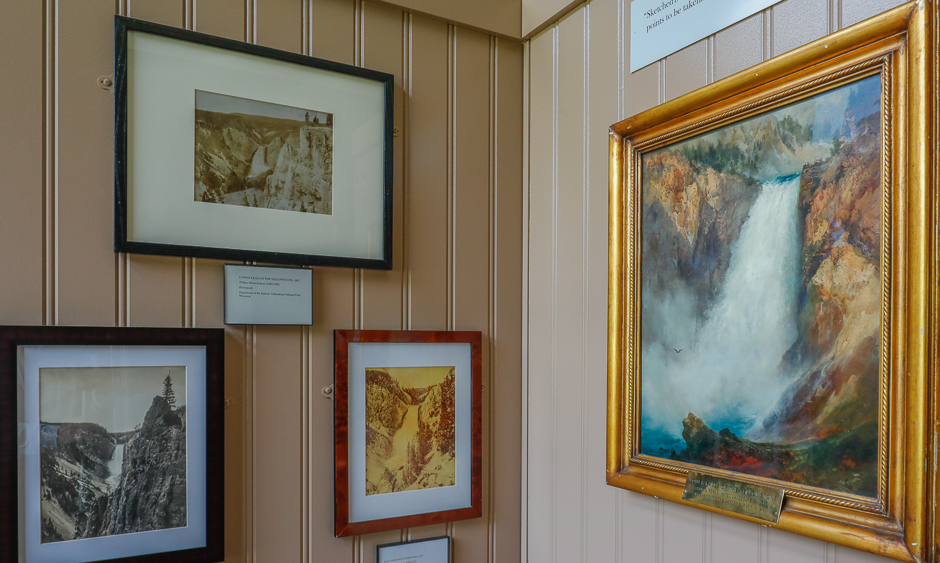
Lower Falls of the Yellowstone — Four Views / Three Photographs by William Henry Jackson and ‘Lower Falls of the Yellowstone, 1885’ by Thomas Moran. Oil on Canvas. Department of the Interior, Yellowstone National Park, Wyoming. (Note: it is said that Moran painted his portrait in the cliffs to the right of the falls.)
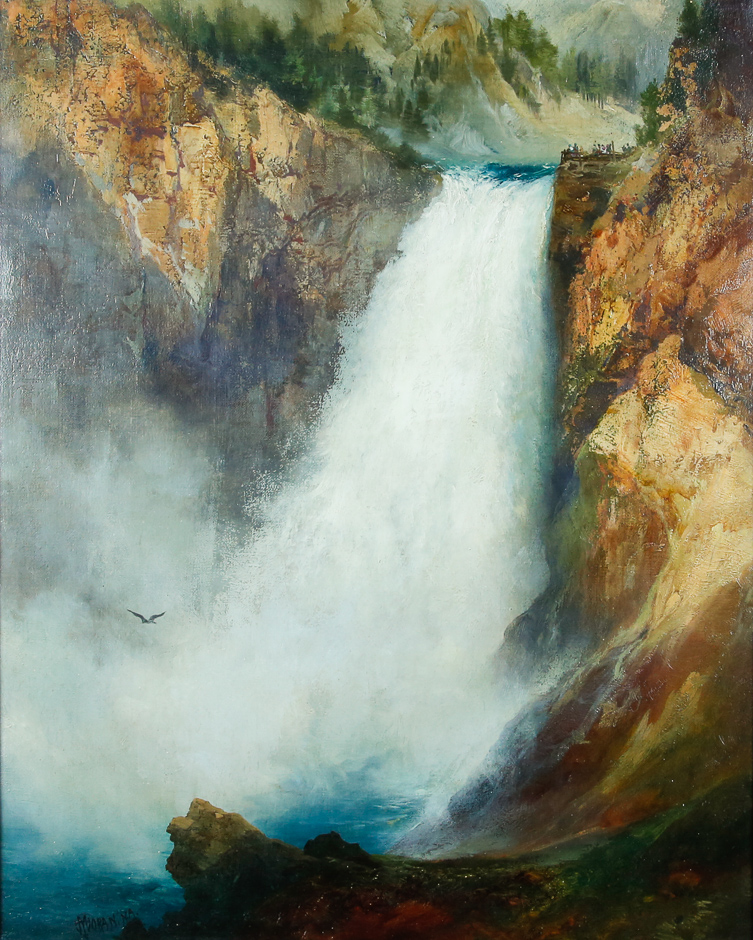
~~~~~~~~~~~~~~~~~~~~~~~~~~~~

“…the road to the lake, looking toward the Yellowstone country (is) glorious; I do not expect to see any finer general view of the Rocky Mountains.” — Moran Journal, 1871.
————————————–
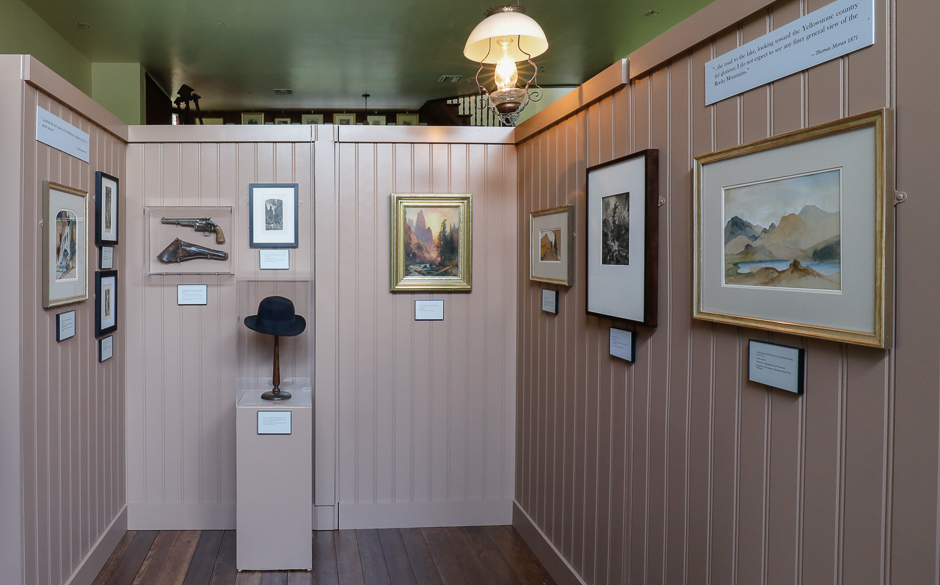
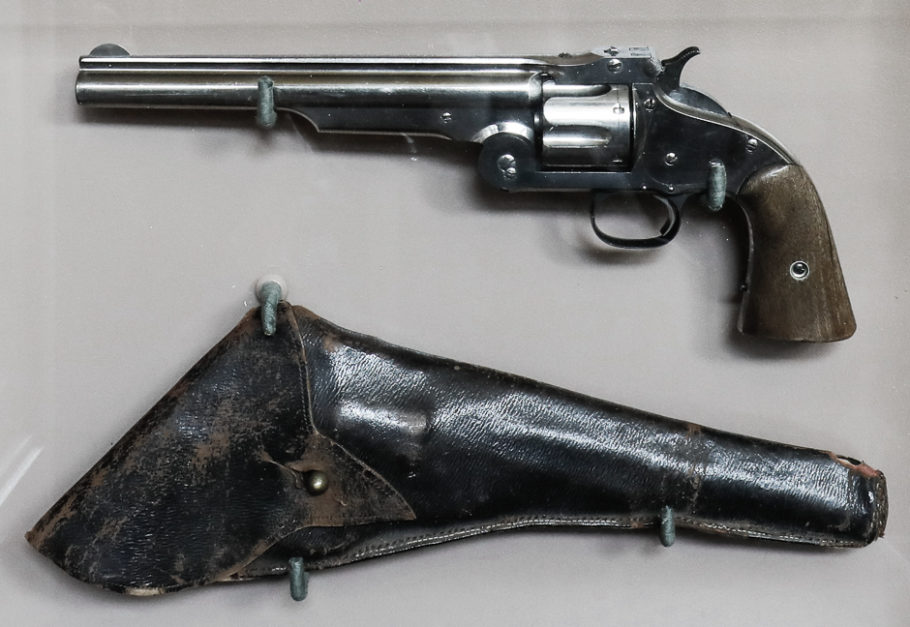
Thomas Moran’s Single Action American Smith & Wesson .44 Calibre Revolver & Holster. Patented in Springfield, MA, August 24th, 1869. Carried by Thomas Moran during the Hayden Expedition in 1871. Department of the Interior, Yellowstone National Park, Wyoming, gift of Ruth Moran.
~~~~~~~~~~~~~~~~~~~~~~~~~~~~
“The outlet of the lake is through an immense gorge…bordered with great cliffs & peaks of limestone, some of them…forming a splendid foreground material for pictures.” — Moran Journal, 1871.
————————————–
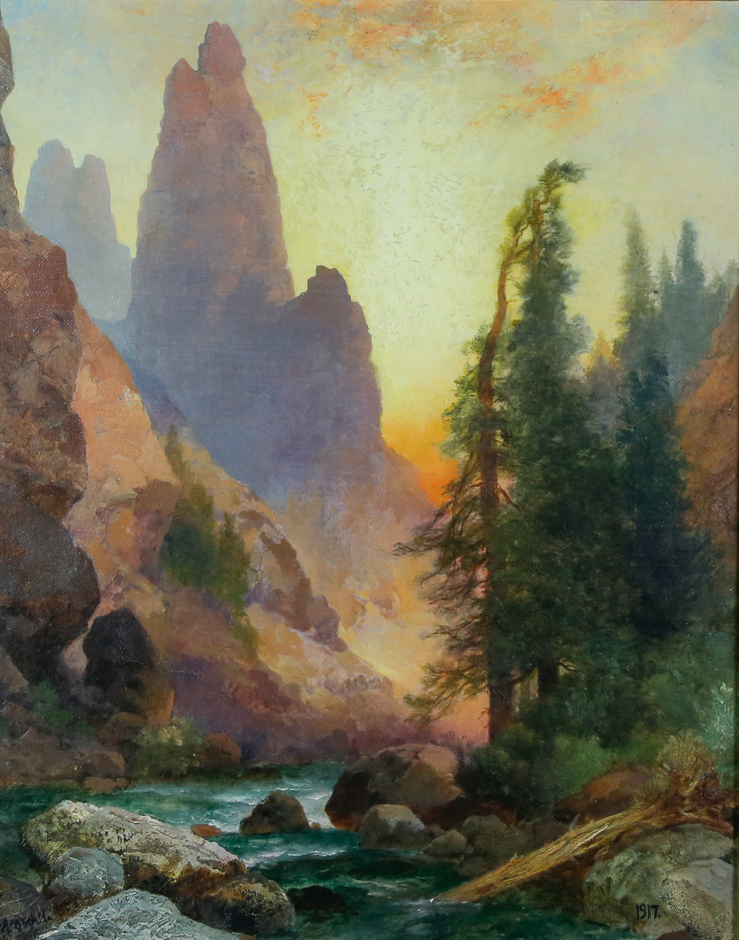
Tower Falls, Yellowstone. Oil on canvas. Thomas Moran, 1917. Guild Hall Museum, gift of Ruth B. Moran.
~~~~~~~~~~~~~~~~~~~~~~~~~~~~~~~~~~
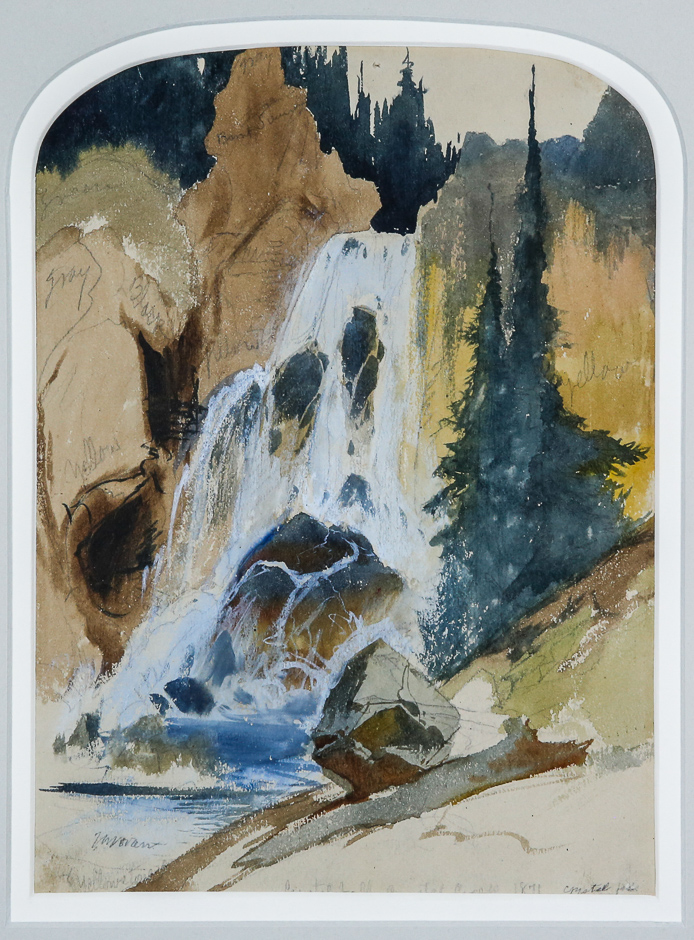
~~~~~~~~~~~~~~~~~~~~~~~~~~~~~~~~~~
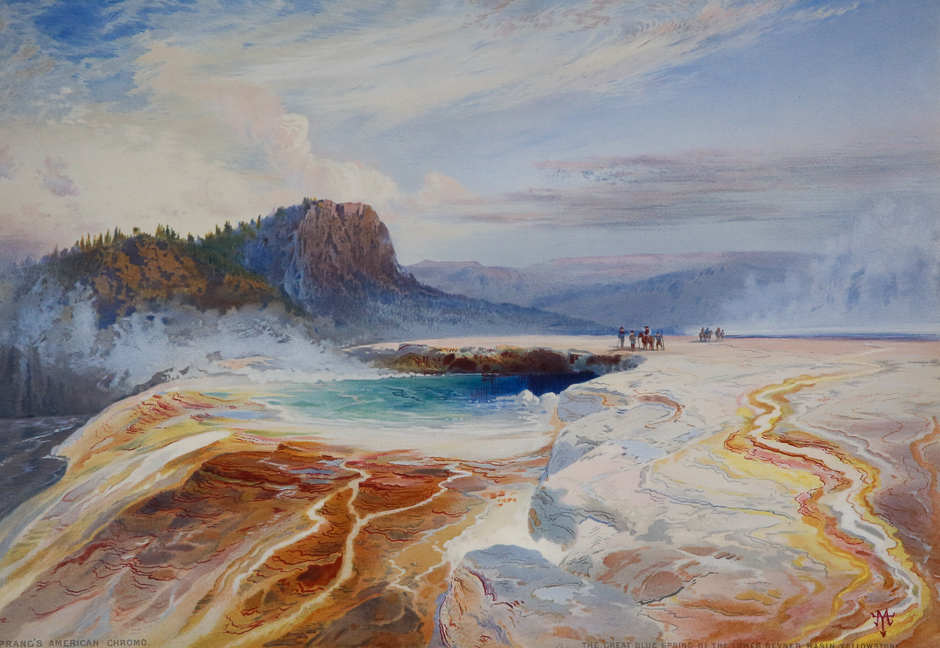
‘The Great Blue Spring of the Lower Geyser Basin, Yellowstone, 1874’ by Thomas Moran. Chromolithograph on paper from an original watercolor by Moran, published in Boston by Louis Prang, one of the greatest innovators of colored printing.
— Department of the Interior, Yellowstone National Park, Wyoming.
~~~~~~~~~~~~~~~~~~~~~~~~~~~~~~~~~~
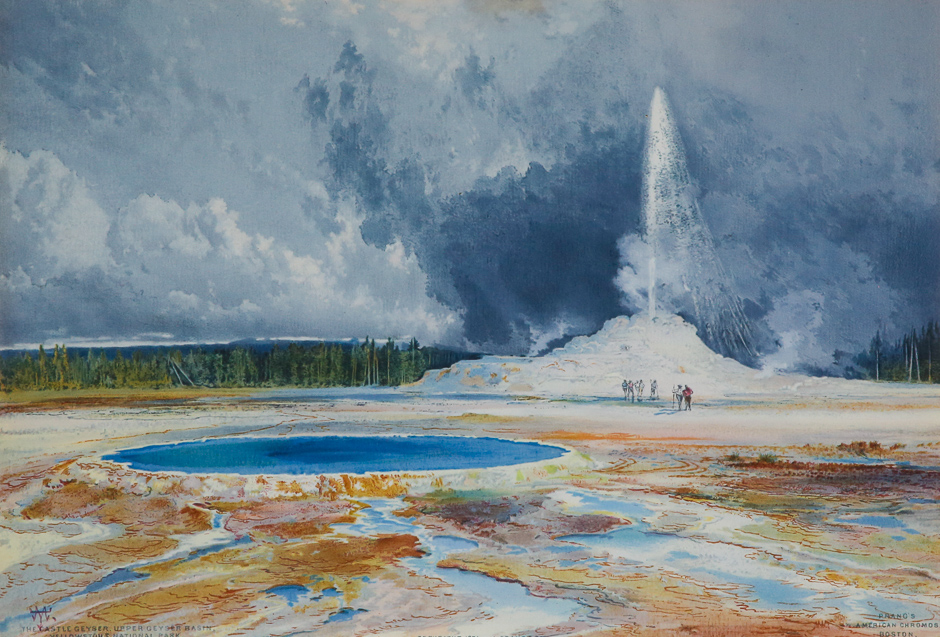
Prang chromolithograph printed in Boston from an original watercolor by Thomas Moran. These were the first multi-color commercial prints that spread the colors that were lacking in the black & white wood engravings. This print was done in 1871 and is in the collection of the National Park Service at Yellowstone.
~~~~~~~~~~~~~~~~~~~~~~~~~~~~~~~~~~
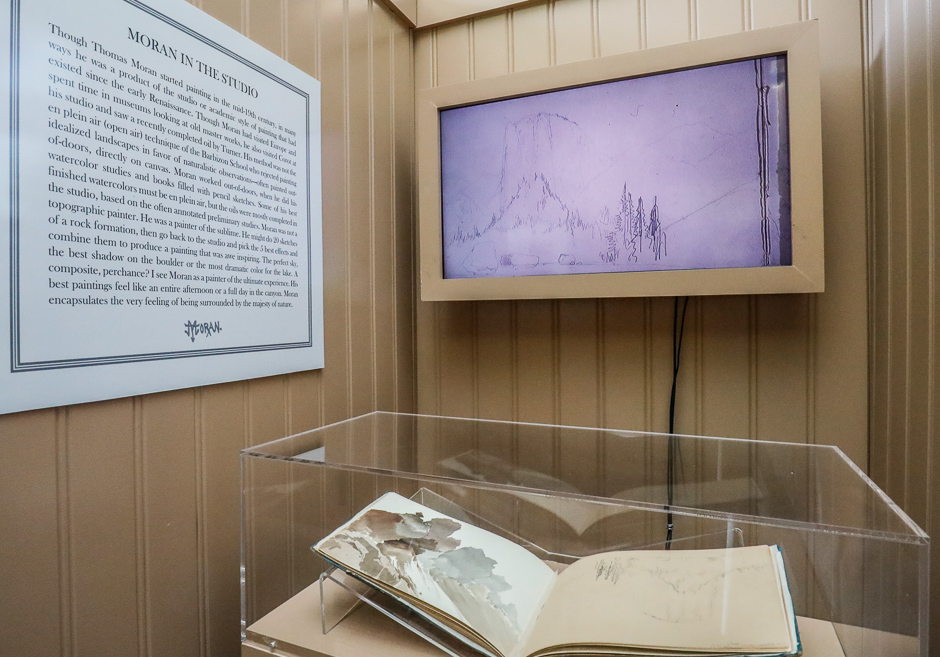
MORAN IN THE STUDIO
Though Thomas Moran started painting in the mid-19th century, in many ways he was a product of the studio or academic style of painting that had existed since the early Renaissance. Though Moran had visited Europe and spent time in museums looking at old master works, he also visited Corot at his studio and saw a recently completed oil by Turner. His method was not the en plein air (open air) technique of the Barbizon School who rejected painting idealized landscapes in favor of naturalistic observations—often painted out-of-doors, directly on canvas. Moran worked out-of-doors, when he did his watercolor studies and books filled with pencil sketches. Some of his best finished watercolors must be en plein air, but the oils were mostly completed in the studio, based on the often annotated preliminary studies. Moran was not a topographic painter. He was a painter of the sublime. He might do 20 sketches of a rock formation, then go back to the studio and pick the 5 best effects and combine them to produce a painting that was awe inspiring. The perfect sky, the best shadow on the boulder or the most dramatic color for the lake. A composite, perchance? I see Moran as a painter of the ultimate experience. His best paintings feel like an entire afternoon or a full day in the canyon. Moran encapsulates the very feeling of being surrounded by the majesty of nature.
~~~~~~~~~~~~~~~~~~~~~~~~~~~~~~~~~~
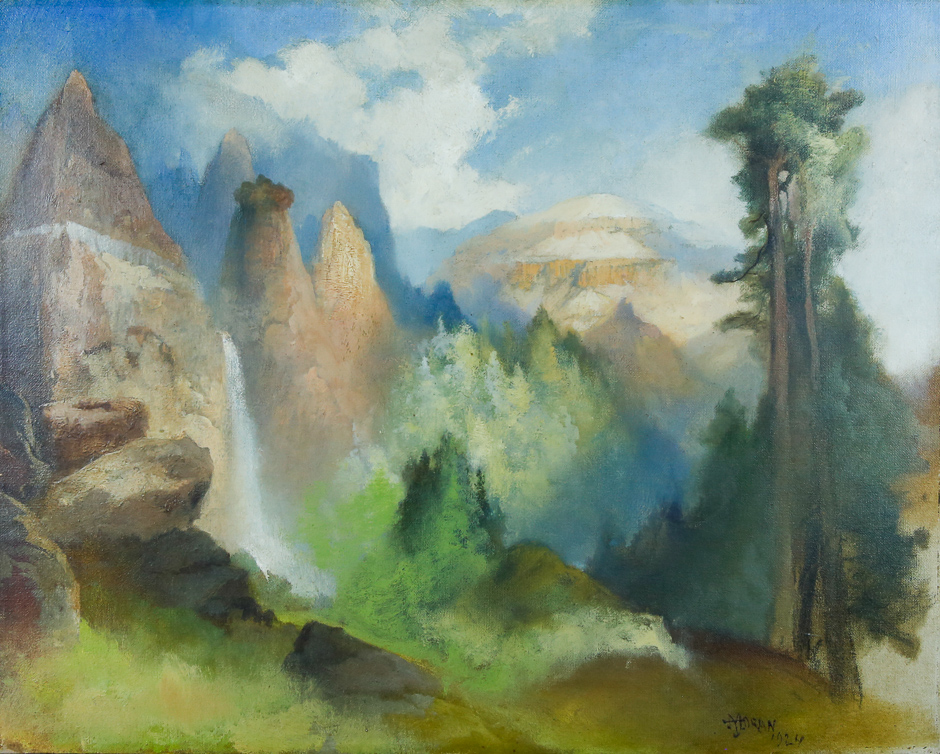
Tower Falls, 1924. This is believed to be the last oil painting that Thomas Moran did before his death in 1926. It was never finished. Department of the Interior, Yellowstone National Park, Wyoming, gift of Ruth Moran.
~~~~~~~~~~~~~~~~~~~~~~~~~~~~~~~~~~
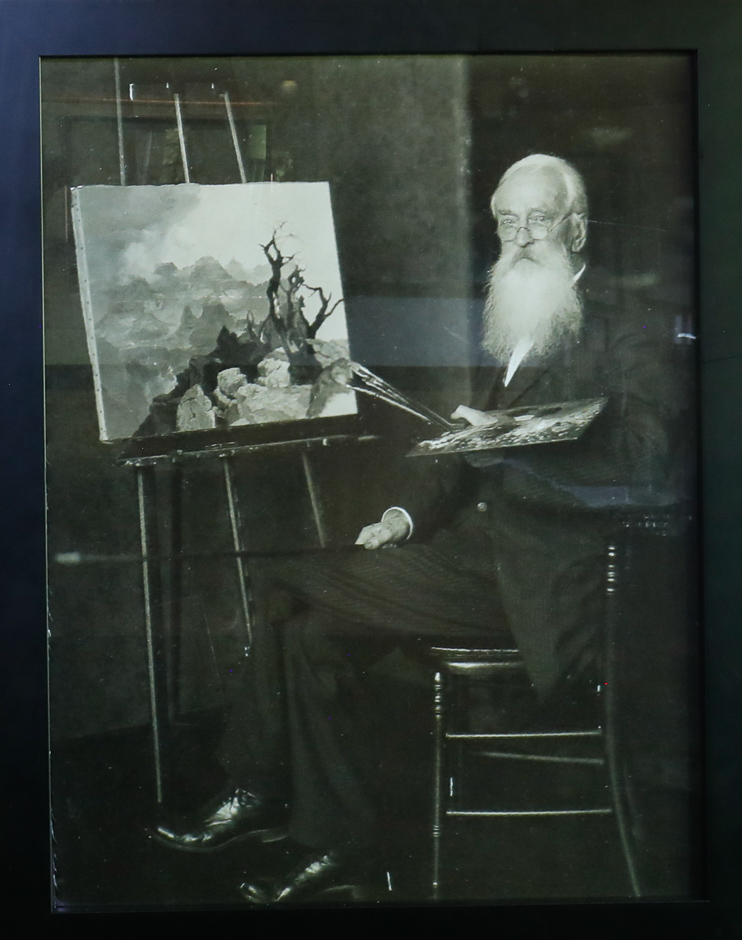
THE FINAL CHAPTER
Thomas Moran’s success was bolstered by both the positive critical reception and the sale of his huge painting (84” x 144”) “Grand Canyon of the Yellowstone” to the US Congress in 1872 for $10,000. In 1874 his “Chasm of the Colorado” was also sold to Congress for $10,000. The artist continued to venture further West for his subjects. Other trips to Mexico, the Caribbean, Florida coast and Europe continued to inspire him. A visit to the tip of Long Island proved to be seductive and in 1883, the artist and his wife purchased 2/3 of an acre of land from Dr. Edward Osborne for $1,500. The lot was directly on East Hampton’s Main Street, facing Town Pond. The two artists moved into their self-designed Queen Anne cottage and studio in the fall of 1884. They, their children, two nephews and new neighbors all enjoyed months together during their summer and early fall residence. His wife died in 1899. He and his daughter Ruth, continued to call East Hampton their seasonal home. Many important paintings were created here including local scenes of Hook Pond and the Atlantic Ocean. With his many sketchbooks and watercolors at hand, he was able to paint Western landscapes and the Grand Canal of Venice. Poor health forced Thomas Moran to give-up on northern winters, so he chose to spend them in California and was a founding member of the Santa Barbara art colony. He tried to visit the Grand Canyon and East Hampton every year. His daughter Ruth wrote a friend in 1924 saying, “…Father…was painting very little.” Thomas Moran died in 1926 at 89 years of age and is buried in the family plot in East Hampton’s old South end Burial Ground.
~~~~~~~~~~~~~~~~~~~~~~~~~~~~~~~~~~
THE CREATION OF THE NATIONAL PARK SERVICE
1832 — Artist George Catlin, who focused on the life of Native Americans, wrote that there should be “by some great protecting policy of the government…a magnificent park…a nation’s park, containing man & beast, in the wilderness and freshness of their beauty.”
1864 — Lincoln signed an Act of Congress granting Yosemite Valley in California to “be held for public use, resort, and recreation…inalienable for all time.”
1870 — Montana writer & lawyer Cornelius Hedges proposed that Yellowstone “should be set aside and protected as a national park.”
1872 — Washington papers began to report that a bill was under consideration in Congress to create Yellowstone as a park. It was thought best to pass the bill at once, before private claimants could intervene. The paintings of Thomas Moran and William Henry Jackson’s photographs were considered the most important exhibits brought before the Committee on Public Lands. On March 1st, the bill was passed and signed by President Ulysses S. Grant. On May 9th, Moran’s “Grand Canyon of the Yellowstone” went on view at the Smithsonian.
1890 — Yellowstone National Park was established with the help of John Muir.
1916 — The National Park Service was established by Congress and signed into law by President Woodrow Wilson.
~~~~~~~~~~~~~~~~~~~~~~~~~~~~~~~~~~

Venice by Thomas Moran. Oil on canvas, 1890. Long term loan, private collection, courtesy of Art Finance Partners, LLC
~~~~~~~~~~~~~~~~~~~~~~~~~~~~~

Fithian Apple Orchard. Etching by Thomas Moran. Gift of the Gardiner Foundation.
~~~~~~~~~~~~~~~~~~~~~~~~~~~~~~~~~~


Thomas Moran (1837-1926) in a photo portrait, c. 1922. His palette, brushes and painting tools are in the collection of the East Hampton Library.
———————
Open Hours:
Summer
June 29-August 31
Fridays and Saturdays | 10am-4pm
Fall
September 1-November 9 | To Be Announced
Image: Thomas Moran. Above Tower Falls, Yellowstone. Courtesy of Guild Hall. Gift of Ruth B. Moran.
Exhibition Sponsors
The Davis Family
Gates Capital Management
Jeff Gates & Mike Moran
Anonymous
————————————-
Visit Online
Mary & Thomas Moran’s House & Studio, East Hampton
Moran Studio / The Art of Restoration 2012 – 2018
—————–
Wall text courtesy of the East Hampton Historical Society.
Photo Essay © Jeff Heatley.
______________________________________________________________________________

